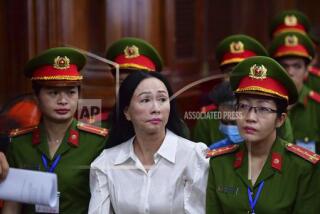Sect With Eclectic Theology Clings to Life in Vietnam
- Share via
TAY NINH, Vietnam — The Cao Dai religious sect is alive and well in communist Vietnam, perhaps because its pantheon of saints includes such diverse theological heavyweights as Confucius, the Buddha and Jesus Christ.
The Cao Daist Missionary Church has a theology so eclectic its patron saints also include 19th-Century French novelist Victor Hugo, World War II British Prime Minister Winston Churchill, Julius Caesar and Joan of Arc.
Headquartered in this city near the Cambodian border and 70 miles northwest of Ho Chi Minh City, the Cao Dai have managed to survive, if not flourish, under the communist regime that unified Vietnam.
Many of the Cao Dai fought with American and South Vietnamese forces against the communists until Saigon fell 15 years ago. Most of the members live in the Mekong Delta along the Cambodian frontier.
The grounds of the Cao Dai Holy See here are dominated by the Great Divine Temple, where the faithful, dressed in white, celebrate Mass daily. God is represented by an eye in a triangle, a symbol that appears on the facades of the temples.
Celebrants at Mass face the altar and the Divine Eye, with the men kneeling on the right, the women on their left. Members are bound by vows that stress obedience to the hierarchy but do not include poverty or celibacy.
Formally established in 1926, the sect contains elements of Confucianism, Taoism, Buddhism and Roman Catholicism.
In an interview over tea, Cardinal Thuong Tho Thanh recalled that during the Indochina War many American GIs visited the Great Divine Temple.
The 80-year-old cleric estimated that there were 3 million members of the sect in Vietnam and Cambodia during the war, but he said many of them have gone to the United States, Canada, Australia, Japan and the Philippines.
“Many of our people fled after the communists took over,” Thanh said.
The sect was established by Ngo Van Chieu, a Vietnamese administrator for the French in Indochina, who received a revelation during a seance that called him to a religious mission. After a period of meditation and study, he announced the formation of Cao Dai.
The Cao Dai leadership allied itself with the Japanese against the French in World War II. A Cao Dai army was established in 1943 during the Japanese occupation of Indochina. After the war, the Cao Dai at first supported, then opposed, Premier Ngo Dinh Diem, who in the 1950s disbanded the sect’s army.
Thanh acknowledged in the interview that life had been hard for Cao Dai members after the communist takeover.
But the elderly cleric, who resembles Ho Chi Minh but rejects the politics of the late communist revolutionary, smiled when he added, “Two years ago, our relations with the government began to improve.”
More to Read
Sign up for Essential California
The most important California stories and recommendations in your inbox every morning.
You may occasionally receive promotional content from the Los Angeles Times.













